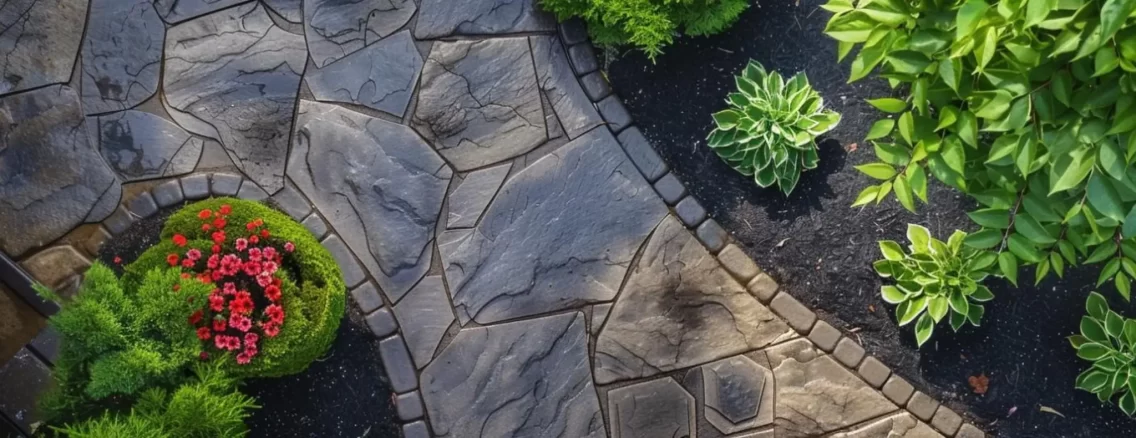What steps do I need to take before I seal?
First, make sure the surface is completely clean and dry. This ensures proper penetration and adhesion as well as increasing the aesthetics of the pavers. The use of a pressure washer is highly recommended, as well as a drying period of at least 24 hours in temperatures above 10 Degrees Celsius (50F). Use Seal King’s cleaners to remove any stains or dirt you may have.
Will sealer make my surface slippery?
Seal King sealers are penetrating sealers that generally have little effect on the concrete/stone surface profile or traction. However, the impact can depend on the surface porosity. High-density surfaces and applying more coats than recommended can affect the surface profile. In areas exposed to foot or vehicle traffic, it is highly recommended to use the right product for the selected surface and, if needed, consider the use of anti-skid additives.
What temperature can I apply sealer?
Ideally, the temperature should be above 10 Degrees Celsius (50 F).
How long does the sealer take to dry?
Most sealers will take between 24 and 48 hours to fully dry, and they must not be exposed to rain during this time as it will wash the sealer away. While waiting for the sealer to dry, you can use plastic sheeting to protect it from rain. It’s advisable to choose a day without rain in the forecast when preparing to seal the concrete.
How many coats of sealer are needed?
It is better to apply two thin coats of sealer rather than one thick coat. Although this may extend the sealing process, it ensures proper protection from water absorption. Achieving even coverage across the surface is more likely with this method, especially on high-density surfaces. Applying more coats than recommended may affect the surface profile, and in areas exposed to foot or vehicle traffic, anti-skid additives may be required.
Does sealer need to be re-applied?
Sealer is crucial for both new and old surfaces. Reapplying the sealer every two to five years is recommended to ensure the ongoing protection of old concrete throughout its lifespan.
How do I take old sealer off my driveway and when should I put on new sealer?
You can remove old sealer by using Seal King Strip-All or other industrial-based strippers. When the surface is completely clean, wait 24 hours in dry weather before re-sealing.
After how long can I apply the sealer on fresh concrete?
It takes approximately 28 days for water to evaporate from new concrete. This process is known as the curing process, and it is highly recommended not to apply the sealer until 28 days after it has been poured.
Can I apply Seal King products over other sealers?
Yes. It can be applied over other sealers but please remember, generally waterborne sealers cannot be applied over oil-based sealers (unless using Seal King’s Premium sealers). Always test sealer compatibility in a selective area before application.
Is it better to roll or spray concrete sealer?
The sealer is generally sprayed or rolled onto the surface. Spraying provides more consistent and complete coverage, minimizing the likelihood of missed or uneven spots. However, rolling can be a better option for older or rougher surfaces. For large-scale applications, sprayers are faster and more efficient, while paint rollers are less expensive and readily available. When applying decorative acrylic sealer or an epoxy floor coating, it is best to use a 1/4″ or 3/8 nap roller.
Can I paint over the concrete sealer?
You cannot paint over the sealer. If you plan to paint, it must be done before applying the sealer.
Can I tint the concrete sealer?
Most acrylic sealers will darken or add a glossy look to your concrete surface. It is best done with a universal pigment concentrate compatible with an acrylic resin solubilized in organic solvents. When the concrete is dry, start by adding the tint pack to the sealer. Shake the container of colour to mix and add it to the sealer. Add a small amount of sealer into the tint pack container, shake, and return to the pail. This is important to ensure all the pigment is used. You can even apply a tinted sealer over previously sealed concrete as long as you use a product compatible with the existing sealer base. Projects using Concrete Dye MUST be sealed every 1-2 years depending on exposure to retain the original colour.
Why is my concrete dark and/or blotchy after sealer is applied?
Acrylic sealers will darken concrete and leave a glossy shine, giving the concrete a “wet look”. Because every slab is unique in its colour and texture, the colour of the concrete after sealer application is difficult to predict. The colour change after sealer application is influenced by factors such as mix design, admixtures, finishing techniques, and porosity. To address concerns about colour change, consider using a penetrating water-repellent sealer or conduct a small test application of a film-forming sealer before full application.
How do I fix roller marks/streaks sealer issues?
Roller marks or streaks can occur when the sealer is applied too heavily, unevenly, or without maintaining a wet edge. Seal King lacquer thinner or a solvent like xylene can be used to re-emulsify the existing sealer and repair issues such as roller marks, streaks, a plastic-like appearance, or white spots. It is crucial to apply the thinner within 24-48 hours after applying a water-based acrylic sealer or anytime for a solvent-based acrylic sealer.
How to repair blushing of sealer?
Blushing occurs when the sealer is applied too heavily or thick or when there is a lot of previous sealer buildup. If the sealer is unevenly applied, it will create light areas where there is less sealer and darker areas where there’s more. If applied by a sprayer, it may appear like “stripes”. Uneven roller application may leave darkened areas. To avoid this, make sure the concrete substrate is completely dry before application and apply the sealer in thin even coats instead of one heavy coat.
To solve this issue, we are highly recommended to use Seal King’s Lacquer Thinner or spraying a solvent like xylene and it will solve the sealer blushing issue.
Apply the lacquer thinner; Pour the lacquer thinner on the surface and allow it to sit for about 1 minute. These chemicals will soften and open the sealer quite easily. Then, pour on a little more of the lacquer thinner (xylene) using a brush or even roller with a light coat. Evenly distribute the lacquer thinner on the sealer and it will improve the appearance of solvent-based sealers. As long as the air is warm and dry the lacquer thinner will melt the sealer back into its liquid form, and the colours of the sealer will clear. Repeat the process if necessary.
How do you remove bubbles from concrete sealer?
When the sealer ‘skins over’ on the surface before all of the solvents have evaporated, bubbling can occur. Bubbling may happen if the application is done in hot weather, the concrete is in direct sunlight, or if the application is too thick. Solvent-based Acrylic Concrete Sealers are designed to enhance the ‘wet look’ with most stamped concrete and provide a sheen to decorative concrete surfaces. When the sealer is applied and penetrates into the concrete cavities and porosity, it dries on the surface before all of the solvent has evaporated. The trapped solvent creates enough pressure to force its way out, resulting in bubbles.
To avoid bubble problems, consider the following tips:
1. Avoid applying sealers during hot weather; it’s best during the coolest part of the day when the concrete is not in direct sunlight.
2. Do not overapply sealer, as it may trap solvents and form bubbles. If necessary, apply two thin coats instead of one thick coat, and roll gently to avoid entrapping air in the coating.
To address this issue, we highly recommend using Seal King’s Lacquer Thinner or spraying a solvent like xylene. Apply the lacquer thinner or spray the solvent when the concrete is not in direct sunlight, preferably late in the coolest part of the day.
Pour the lacquer thinner on the surface and allow it to sit for about 1 minute. These chemicals will effectively open the sealer. Then, apply a little more and use a brush to apply a light coat. As long as the air is warm and dry, the lacquer thinner will melt the sealer back into its liquid form, allowing the trapped solvent bubbles to escape. Let the sealer sit overnight to dry properly, and repeat the process if necessary.
Note: For the correct application of lacquer thinner or a spray solvent like xylene, ensure no rain is forecasted for the next 24 hours, the temperature is between 10°C-30°C during applications, and the surface is warm to the touch, sound, clean, and free of oil, grease, dirt, and other contaminants that may reduce or prevent proper adhesion. Shake well or stir the product before and during application, and always conduct a test section.
Why is my concrete sealer peeling/flaking?
Acrylic concrete sealer peeling off can be caused by various factors. Here are some of the main reasons why this issue might occur:
1. Poor Surface Preparation: One of the most common reasons for acrylic sealer peeling is inadequate surface preparation. If the concrete surface is not properly cleaned, free of contaminants such as oil, grease, or other residues, or if efflorescence (white, powdery deposits) is present, and if the surface has not been profiled to accept the sealer, it may not adhere well, interfering with the sealer’s adhesion and causing it to peel.
2. Application Method: Peeling issues can arise if the product is applied too heavily or if there are too many coats of sealer on the concrete. Applying the sealer either too thick or too thin can lead to peeling problems.
3. Freeze-Thaw Cycles: In areas with low temperatures, the expansion and contraction of water within the concrete can cause the sealer to peel off. Ensure that the sealer is suitable for use in the local climate.
4. Moisture Issues: Problems related to moisture can result in sealer peeling. The standard waiting time for concrete to cure is about 28 days. If the concrete was not dry when the sealer was applied, or if there is excess moisture migrating from the concrete, it can cause the sealer to lose adhesion and peel. It’s essential to wait for the concrete to cure and reach the appropriate moisture content before applying the sealer. This typically takes about 28 days, which is the standard curing time for concrete to achieve its full strength and durability.
5. Incompatibility: Some acrylic sealers may not be compatible with the underlying concrete surface, leading to adhesion issues and eventual peeling. This explains why the sealer peeled off. In Seal King, we offer two types of concrete sealer. The first one keeps newly placed concrete moist by reserving the water in the concrete, decelerating the evaporation processes, preventing cracks and chipping. Sealing and protecting take place once the concrete has cured. The second one is a sealer that must be applied to old cast concrete, 28 days and more, to protect, enhance, and beautify the surface.
To prevent acrylic concrete sealer peeling, it’s crucial to follow proper surface preparation procedures, select the right sealer for the application, and ensure that the conditions during and after application are suitable for the sealer to bond effectively. Regular maintenance and resealing when necessary can also extend the life of the sealer and the concrete surface.
How do I remove sealer that has peeled?
Scrub the concrete to remove any loose material, using a scraper or putty knife to gently eliminate the peeling sealer. Clean the concrete surface by using a mixture of water and mild detergent to remove any dirt, dust, or residues. If the concrete is dry enough, pressure wash it, being careful not to damage the concrete. Allow the surface to dry completely for three days after pressure washing. In some cases, a sealer stripper, such as Seal King Strip All, may be required to remove any remaining product from the surface. Afterward, perform the necessary steps and reapply the sealer.
Why, after sealing, did the surface turn white?
A white or cloudy colour is caused by moisture. Concrete/Stone is a porous material which will accept water, moisture, and water vapour. When the temperature rises high enough, this water vapour or the moisture doesn’t always remain trapped in the concrete/stone, and the water vapour under the sealer sometimes changes to a liquid (condensation), and a whitening effect could occur. Some reasons the surface may have turned white after sealing:
- Application on a Wet Surface: If the sealer is applied when the surface is still wet, it might appear dry but could retain moisture in the stone or sand joints. It’s crucial to ensure the surface is completely dry before applying the sealer, as water and oil-based sealers do not mix well.
- Accumulation of Thick Sealer Coat: Over time, an excessive build-up of sealer can form a thick coat that prevents moisture from escaping. This trapped moisture leads to a white appearance on the surface.
- Chemical Reactions with Cleaning Products: Chemical reactions between the sealer and cleaning products, which haven’t been adequately rinsed, can contribute to the whitening effect on the surface.
- Drainage Issues: If there’s a drainage problem, water or moisture may become trapped beneath the stone and base. As this tainted water evaporates through the brick, it can result in surface whitening.
To solve this issue, we highly recommend using Seal King’s Lacquer Thinner or spraying a solvent like xylene.
Apply the lacquer thinner, pour the lacquer thinner on the surface, and allow it to sit for about 1 minute. These chemicals will open the sealer quite easily. Then, pour on a little more and use a brush/roller with a light coat. As long as the air is warm and dry, the lacquer thinner will melt the sealer back into its liquid form; the moisture will escape, and the colour of the sealer will clear.
How can I fix the white appearance on the surface after sealing?
If you notice a white appearance on the surface after sealing, follow these steps for remediation:
- Obtain Seal King’s Lacquer Thinner: Acquire Seal King’s Lacquer Thinner for effective removal of the tainted sealer.
- Application: Apply the lacquer thinner over the affected area using a roller or pump sprayer. The tainted sealer should disappear upon application.
- Repeat if Necessary: If needed, repeat the application process until the whitening issue is resolved. It’s important to note that lacquer thinner should not be used with water.
- Scrubbing for Persistent Issues: If the problem persists, use a scrub brush to apply lacquer thinner onto the sealer. Remove excess material with a rag, shop vac, or pressure washer.
WARNING: When using a pressure washer, be cautious of potential splashing or spilling onto other areas.
By following these steps, you can effectively address and resolve the issue of surface whitening after sealing.
How do I use Strip All?
DIRECTIONS FOR APPLICATION
The process of stripping by chemical means requires time and keeping the stripper active and wet. Chemical strippers only work when they are active.
• A test section is always recommended before starting the general application to ensure desired results.
• The product may be sprayed, brushed, or poured out and squeegeed evenly across the surface to be treated.
• Work in small areas not larger than 10 sq. ft.
• Recommended temperature: 10°C-28°C.
• Ensure the surface is completely dry and free of water. Apply on dry surfaces.
• Apply Strip All directly from the pail.
• Allow the stripper to stand for 2 minutes to soak into and soften the sealer for removal. Do not allow the stripper to dry on the surface. Reapply Strip All if necessary and if it’s starting to dry to keep the surface wet with the product.
• Perform a test by scratching the sealer with a plastic putty knife to see if the sealer lifts from the surface.
• If the sealer is gummy but not released, give it an additional 2 minutes before re-testing. Do not allow the stripper to dry on the surface.
• Scrub the surface using a nylon scrub brush (never use a steel brush).
• Use high-pressure wash to remove the stripper and sealer.
• Difficult areas may need a second treatment. The sealer will re-adhere if not completely removed.
• Repeat the process if necessary; heavy coatings may require a second treatment.
• Coverage: Approx. 100 sq.ft. / 1 Gal.
What is Efflorescence?
Efflorescence is a salt, a byproduct of calcium oxide (lime) and water, found in the ground and in construction materials such as brick, cement, lime, sand, clay, and admixtures. Typical efflorescence is white but can also appear in different colours. Water from rain, snow, the ground, and the water used in cement during construction can start dissolving salts in building materials. When the temperature rises high enough, the water moves them to the surface of brick walls or cement foundations. As water evaporates, the salts are left behind, resulting in what you see as efflorescence.
How do you clean Efflorescence?
Use Seal King’s Efflorescence Cleaner and follow directions as printed on the product label. Generally, it’s highly recommended to wait about 60 days before applying an efflorescence cleaner on new pavers. It’s also important to note that even after proper cleaning, efflorescence may come back in the future. In that case, you will have to clean them again. However, using an efflorescence cleaner can help ensure your pavers keep looking clean and fresh!
Removing efflorescence from pavers and concrete is not difficult, but if done incorrectly, you can cause severe damage to your pavers, so follow the recommendations carefully.
Seal King’s Efflorescence Cleaner is specially formulated to remove ground-in dirt and efflorescence from paving stones and concrete surfaces. Here are some steps that you can follow:
• A test section is always recommended to ensure results meet expectations.
• Wet the paver/concrete surface with water before using any chemical cleaner to keep the cleaner from penetrating into the stone and further opening pores that encourage efflorescence.
• Blow off any excess water that may have ponded in low areas. The surface should be wet but not puddled.
• Work in up to 100-200 square foot sections at a time, depending on conditions. Do not apply to freshly poured concrete or a surface that has already been sealed.
• Attach the garden hose to the attachment sprayer. Push the tab inwards to apply the diluted product on the wet paver surface (Dilution: 1 part Seal King’s Efflorescence Cleaner to 10 parts water). Ensure you are applying a sufficient volume of cleaner to the surface.
• Wait 1-2 minutes for the product to react; the surface will begin to fizz. This is a good sign. Wait until fizzing stops, then agitate the cleaner on the surface using a hard-bristle brush (never use a wire brush).
• Rinse the surface thoroughly with a garden hose using a pressurized garden hose to remove any excess residue. Do not use a pressure washer. Ensure all traces of foam are completely removed (Note: Never let the cleaner dry up on the paver surface!).
• Repeat the process until the entire surface is completely free of debris and/or stains. (Note: It may be necessary to allow the surface to dry to see if the efflorescence has been completely removed.)
• Coverage: Approx. 800 sq.ft. / 2L (64oz).
How do I fix Polymeric Sand that was sealed and turned white?
Wet Polymeric Sand Issue (Trapped Water): The sand is misted with water to activate the polymer bond. The problem arises when the sand is not completely cured and sealed.
To solve this issue, we are highly recommended to use Seal King’s Lacquer Thinner or spraying a solvent like xylene and it will solve the sealer whitening problem.
Apply the lacquer thinner; Pour the lacquer thinner on the surface and allow it to sit for about 1 minute. Lacquer Thinner will emulsify the current sealer and will open the sealer quite easily. Then, pour on a little more and use a brush with a light coat. As long as the air is warm and dry the lacquer thinner will melt the sealer back into its liquid form and the moisture will escape, and the colors of the sealer will clear. Repeat the process if necessary. you can re-apply the sealer for areas where the sealer is stripped off.
Kindly note for the right application, make sure no rain is forecasted for the next 24 hours, the temperature must be between 10°C-25°C during applications. The surface should be warm to the touch, sound, clean and free of oil, grease, dirt, and other contaminants that may reduce or prevent proper adhesion. shake well or stir product before and during application. A test section is always recommended.
When using Seal King’s Polymeric Sand, should I put the sand in before or after I seal?
It is recommended to put the sand in BEFORE you seal. Please note: It is important to make sure the sand is completely swept into the joints before activating (with water) the polymeric sand. Please make sure you allow 24-48 hours of drying time before sealing the surface. Also note, that although sand joints appear to be dry they still may maintain moisture. Please check the sand thoroughly to ensure it is completely dry.
How do you store the products when not using them?
Refer to our product data sheets. Usually, our products must be stored in a dry cool environment (above 0 Degrees Celsius). Also, keep products away from children.






